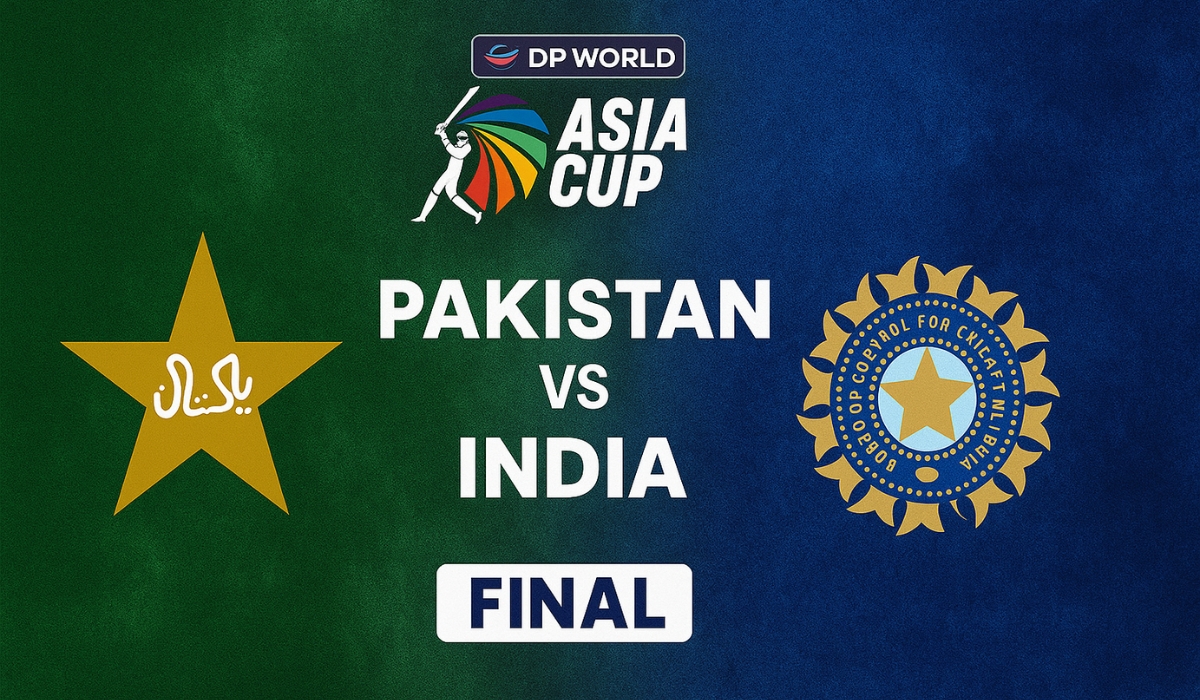
I. Prologue: A Historic Showdown in the Desert
For over four decades, the Asia Cup has served as a crucible for some of cricket’s most intense rivalries, but never before has it culminated in the most anticipated of all: a final between India and Pakistan. Sunday, September 28, 2025, marks a historic first, as the two cricketing powerhouses are set to clash at the iconic Dubai International Stadium with the continental title on the line. The gravity of this occasion is immense, transcending the sport itself and capturing the attention of millions worldwide. The final is not merely a contest for a trophy; it is a symbolic battle for supremacy, steeped in a history of cultural, political, and sporting confrontation.
The atmosphere in Dubai is expected to be electric. General seating tickets for the single-day final have already sold out, a testament to the unparalleled fan fervor surrounding this match. The stadium, a neutral venue that has become a second home for this rivalry, will be packed with a global audience, each person a witness to a new and unforgettable chapter in this storied saga. This report provides a comprehensive analysis of the factors at play, from the deep-seated historical context to the modern-day tactical battles, offering a nuanced perspective on what promises to be one of the most significant matches in recent memory.
II. A Legacy of Confrontation: The Rivalry Beyond the Boundary
The India-Pakistan cricket rivalry is universally regarded as the most captivating in sports, and its intensity is rooted in a complex tapestry of shared history and political animosity. The 1947 partition of British India, which led to the creation of two independent nations, left a lasting impact on their relationship. Cricket emerged as a powerful proxy for national pride and identity, with every match carrying the emotional weight of a deeper, ongoing narrative. When players take the field, they are not just representing a team but embodying the aspirations and historical grievances of their nations, a dynamic that elevates every contest to an emotionally charged spectacle.
This rivalry has produced some of cricket’s most memorable, and at times, heartbreaking moments. The 1986 Austral-Asia Cup final remains a legendary tale, defined by Javed Miandad's last-ball six off Chetan Sharma to secure Pakistan's first Asia Cup title. In 2012, the rivalry witnessed the spectacular emergence of a new nemesis when Virat Kohli’s masterful knock of 183 dismantled Pakistan’s bowling attack. Other matches, such as Shahid Afridi’s fearless cameo in 2014, have reaffirmed the unpredictable nature of these encounters. The emotional highs and lows, from Harbhajan Singh’s last-over heroics in 2010 to Hardik Pandya’s game-winning six in 2022, have collectively etched this rivalry into the permanent memory of millions of fans.
While the rivalry's history is rich and varied, the modern T20 era tells a story of clear Indian dominance. A crucial turning point occurred on September 24, 2007, when a young Indian team, led by MS Dhoni, clinched the inaugural T20 World Cup by edging out Pakistan in a tense final. As a member of that victorious squad, Irfan Pathan has reflected that this victory marked the beginning of India's consistent success against Pakistan in the shortest format. This historical moment did more than just secure a trophy; it instilled a psychological edge in the Indian team that has proven difficult for Pakistan to overcome. The statistical evidence corroborates this narrative, with India holding a commanding T20I head-to-head record of 12 wins to Pakistan’s 3. In the T20 version of the Asia Cup, India's superiority is even more pronounced, with a 4-1 record against Pakistan. The final thus presents Pakistan with an opportunity not only to win a title but to break a 15-year trend of psychological and statistical subordination in the T20 format.
III. The Road to the Grand Finale: A Tale of Contrasting Journeys
The paths taken by India and Pakistan to reach this historic final could not be more different. India’s journey has been one of consistent, clinical dominance, showcasing an unbeaten record that solidified their status as the tournament’s top contender. They swept through the group stage, finishing at the top of Group A with a perfect three wins from three matches. This flawless performance continued into the Super Four stage, where they comfortably secured their place in the final with a game to spare. A decisive 41-run victory over Bangladesh, which featured a brilliant 75 from Abhishek Sharma, guaranteed their spot in the title clash, leaving the race for the second finalist wide open.
In contrast, Pakistan’s campaign has been a more dramatic and resilient affair. They progressed from Group A in second place, but their Super Four journey was immediately complicated by a loss to India. Their survival hinged on a crucial five-wicket victory over Sri Lanka, a do-or-die encounter that revived their hopes. This hard-fought win transformed their final Super Four match against Bangladesh into a "virtual semi-final". In a gripping contest, Pakistan's bowlers successfully defended a low total, showcasing their grit and nerve to secure their place in the final and set up a third encounter with their arch-rivals in the tournament.
The following table provides a clear overview of the final Super Four standings, illustrating India's commanding position and Pakistan's hard-won qualification.
Asia Cup 2025 Super Four Standings
Team | Matches | Won | Lost | Points | NRR |
India | 3 | 3 | 0 | 6 | +1.357 |
Pakistan | 3 | 2 | 1 | 4 | +0.329 |
Bangladesh | 3 | 1 | 2 | 2 | -0.831 |
Sri Lanka | 3 | 0 | 3 | 0 | -0.590 |
IV. Team Analysis: Strengths, Standouts, and Strategic Nuances
India: The Unbeaten Armada
India’s formidable run to the final has been built on the twin pillars of explosive batting and a potent bowling attack. At the top of the order, the opening partnership of Abhishek Sharma and Shubman Gill has been a revelation, providing consistent and blistering starts that have set the tone for India's innings. Abhishek Sharma has been the primary catalyst for India's success, leading the tournament's scoring charts with 248 runs in just five innings at an astonishing strike rate of over 200. His destructive power in the powerplay, highlighted by his game-changing knocks of 75 against Bangladesh and 74 against Pakistan, has been a key factor in India's ability to consistently post or chase down high totals. This aggressive approach has given India a significant advantage and validated the team's "game speaks, not words" mentality, as articulated by vice-captain Shubman Gill after a recent victory.
The team's success has also been significantly shaped by its strong and balanced bowling attack, with a particular emphasis on spin. Kuldeep Yadav has been the standout bowler, leading all wicket-takers in the tournament with 9 wickets in four matches. Pakistan's batters struggled to handle India's spin duo, including Kuldeep, in their previous encounter, a tactical vulnerability that India will look to exploit in the final. The deep batting lineup, extending to number eight, provides further assurance and strategic flexibility, allowing India to play with an aggressive mindset from the very first ball.
Asia Cup 2025 Top 10 Run Scorers
Player | Mat | Inns | NO | Runs |
Abhishek Sharma (IND) | 5 | 5 | - | 248 |
Saif Hassan (BAN) | 4 | 4 | - | 178 |
Sahibzada Farhan (PAK) | 6 | 6 | - | 160 |
P Nissanka (SL) | 5 | 5 | - | 154 |
Towhid Hridoy (BAN) | 6 | 6 | 1 | 139 |
Fakhar Zaman (PAK) | 6 | 6 | 1 | 135 |
Mohammad Haris (PAK) | 6 | 5 | - | 131 |
BKG Mendis (SL) | 5 | 5 | 1 | 122 |
Litton Das (BAN) | 4 | 4 | - | 119 |
Shubman Gill (IND) | 5 | 5 | 1 | 111 |
Export to Sheets
Pakistan: The Resilient Underdogs
Pakistan’s path to the final has been a testament to their fighting spirit, but it has also exposed some key vulnerabilities. The team's strength remains its formidable pace attack, particularly the duo of Shaheen Afridi and Haris Rauf. Rauf, with 14 wickets in his T20 Asia Cup career, is now the joint-highest wicket-taker in the tournament's history. While their form has been noted as inconsistent, their ability to generate pace and take wickets in bursts makes them a constant threat, capable of turning the game on its head at any moment.
On the batting front, Pakistan has faced a significant challenge. Their leading run-scorers in the tournament, Sahibzada Farhan and Fakhar Zaman, have both scored 156 and 122 runs, respectively. However, their strike rates are modest when compared to India's aggressive top order, a point of concern that Pakistan will need to address to set a competitive total or successfully chase a target. Pakistan’s hopes of an upset will depend on a collective effort, with standout performances from their key bowlers to disrupt India’s momentum and a more aggressive and consistent approach from their batters to challenge India’s deep lineup. Asia Cup 2025 Top 10 Wicket Takers
Player | Team | Matches | Wickets | Runs | Avg |
Kuldeep Yadav | India | 5 | 12 | 97 | 8.8 |
Junaid Siddique | UAE | 3 | 9 | 57 | 6. |
Shaheen Shah Afridi | Sri Lanka | 6 | 9 | 144 | 16.00 |
Mustafizur Rahman | Bangladesh | 6 | 9 | 171 | 19.00 |
Haris Rauf | Pakistan | 4 | 9 | 115 | 12.77 |
Saim Ayub | Pakistan | 6 | 8 | 112 | 14.00 |
V. The Battle Royale: Crucial Player Match-Ups
The final will be a series of micro-battles, each with the potential to swing the momentum of the game. The most critical of these encounters will likely take place in the opening overs.
Abhishek Sharma vs. Shaheen Afridi
The tactical battle between India's explosive opener Abhishek Sharma and Pakistan's new-ball specialist Shaheen Afridi could decide the outcome of the match. Their previous encounter in the Super Four stage was a microcosm of this high-stakes confrontation. From the very first ball, Abhishek signaled his intent, a dynamic approach that ultimately led to a verbal spat with Afridi and Haris Rauf. Former Pakistani fast bowler Shoaib Akhtar has identified Abhishek’s early dismissal as the key to Pakistan’s success, recognizing that his blistering strike rate is the primary engine of India’s top order. For Pakistan to have a chance, they must disrupt this momentum, and Afridi's ability to take early wickets with the new ball makes him the ideal candidate for the job.
Pakistan's Batting vs. India's Spinners
Another crucial confrontation will pit Pakistan’s middle order against India’s potent spin attack. In their previous meeting, Pakistan’s batters found it difficult to handle India’s wrist spinners, particularly Kuldeep Yadav. The pitch in Dubai is known to be slow and conducive to spin, a factor that will amplify Kuldeep’s effectiveness and pose a significant challenge for Pakistan. For Pakistan to post a competitive total or manage a difficult chase, their batters must find a way to counter India’s spin stranglehold in the middle overs.
The Psychological Game
Beyond the on-field skills, the final will be a test of nerve and a psychological battle fueled by recent tensions. The rivalry has been marred by a series of high-profile incidents, from a handshake dispute to on-field altercations. Following India’s six-wicket victory in the Super Four, the drama spilled off the field when Haris Rauf’s wife posted a now-viral Instagram story with a "6-0" hand gesture, a clear reference to a political claim, and a caption that read, "Lost the match but won the battle".
These incidents are not mere footnotes; they are a direct consequence of the deep-seated political and historical narratives that are inextricably linked to this rivalry. The players are not just competing for a sporting trophy; they are actively involved in a psychological contest where every action and word carries immense nationalistic weight. This adds a unique and intense layer of pressure that is unparalleled in any other sporting rivalry, and the team that can manage this immense emotional weight will hold a significant advantage on the day.
VI. The Dubai Factor: Pitch, Conditions, and Tactical Choices
The Dubai International Cricket Stadium, the venue for the final, is a neutral ground that has become an arena for some of the greatest T20 battles. A key element to understanding the final is the nature of the pitch. The surface is typically dry and slow, causing the ball to grip and making strokeplay difficult. This characteristic favors bowlers who can vary their pace and spin, a factor that could play directly into the hands of India's attack. In the previous Super Four match at this venue, India successfully defended a total of 168, with their spinners effectively stifling the opposition's chase.
A critical tactical consideration for the final will be the toss. The forecast for Sunday, September 28, is for clear, warm conditions, with a high of 96°F and a low of 85°F. This confirms the likelihood of a hot, dry day leading to a humid evening, where dew can become a significant factor.. Dew makes it difficult for bowlers to grip the ball, giving a clear advantage to the chasing side. This presents a fascinating tactical dilemma for the captain who wins the toss. They must weigh the initial advantage of batting first on a slow pitch against the potential benefit of chasing a target when dew has neutralized the bowling attack. The decision to bat or field first will not be a simple choice; it will be a high-stakes tactical gamble that could directly influence the outcome of the match.
VII. The Final Verdict: Prognosis and Prophecy
The Asia Cup 2025 final is poised to be an unforgettable chapter in a rivalry that transcends sport. Based on a comprehensive analysis of team form, historical data, and recent performances, India enters the final as the clear and undeniable favorite. India's unbeaten run, combined with a dominant T20I head-to-head record and the explosive form of players like Abhishek Sharma and Kuldeep Yadav, provides a compelling case for their victory.
However, the inherent unpredictability of the Pakistan cricket team, coupled with the immense emotional weight of the occasion, means the outcome is far from a foregone conclusion. For Pakistan to pull off an upset, they will need a few key elements to align perfectly. The aggressive pace duo of Shaheen Afridi and Haris Rauf must be at their absolute best, taking early wickets to expose India’s middle order. Additionally, a standout performance from a batter will be required to overcome their team's struggles and challenge India’s clinical bowling attack.
The final is more than just a game; it is a global spectacle that will be a testament to skill, nerve, and national pride. Regardless of the outcome, this historic first-ever Asia Cup final between India and Pakistan will serve as a powerful reminder of why this rivalry remains one of the most compelling and intense in all of world sport.
India vs. Pakistan Head-to-Head Records
Format | Total Matches | India Wins | Pakistan Wins |
T20 Internationals | 15 | 12 | 3 |
Asia Cup (Overall) | 21 | 12 | 6 |
Asia Cup (T20 format) | 5 | 4 | 1 |


